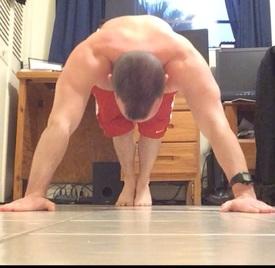Question about exercising to failure

Samuraiko
Posts: 180 Member
I've read that when doing strength training, you should go for enough weight that at the end of a set, you just cannot do another rep (while still maintaining proper form). If you're doing 3 sets, though, do you want that failure to happen at the end of set #3, or should that happen at the end of EACH set you do? (And if the latter, how much time do you take between sets so that you can get through all your reps again?)
I know, probably a stupid question, but I don't want to accidentally give myself a hernia through ignorance.
I know, probably a stupid question, but I don't want to accidentally give myself a hernia through ignorance.
0
Replies
-
At the end of the third set. Same applies if you were doing low weight high reps for muscle to being.0
-
not a stupid question- most people don't truly train to full failure and if they do- they don't do it regularly.
I personally really like doing it- and I find when I do pyramid styles I like it- so I start at a working set- and just keep adding weight- AMRAP until I fail.
I don't mind it at all- but for sets of something like 5-10- you want to be struggling through the last reps- the first SET of reps shouldn't be excessively hard- but by the time you get half way through your second set you shouldn't be grinning about how easy it is.0 -
You don't have to lift to failure to make progress. If you want to, then I would recommend doing so on the final set. Pay attention to how well you are recovering between workouts though as you might be asking a lot of yourself.0
-
It's a great question. I didn't know if I was doing it right. I usually really start to feel it on my second set. I rest a little longer between set 2 and 3 accordingly. My first set isn't exactly easy feeling, but it's no problem to complete. (Please let me know if that sounds off, y'all!).0
-
About doing x amount of reps... you're supposed to do weight that is challening enough that you can do the prescribed reps, and few more, not NO more. You should always be leaving a little bit in the tank so you can stay more fresh and get through your program for the day.
Also it bears mentioning that failing a set, and actual muscle failure are two different things. The first is where you just can't generate the power to finish the set. The second is where the muscle is actually exhausted and stops responding. In other words, one has to do with strength level while the other has to do with endurance/conditioning.
If you're talking about muscle failure, this is only supposed to be used at the end of your routine (programmed intelligently) since it will keep your failure sets from affecting any follow up work. Also, it's not critical, but can be helpful if, again, you use it intelligently.
Either way, get on a program if you haven't already, and you won't have to worry about stuff like this. Good programs are SL 5x5, ICF 5x5 (just like SL 5x5 but has assistance work), and New Rules of Lifting for Women (though kinda fluffy, excellent book).0 -
About doing x amount of reps... you're supposed to do weight that is challening enough that you can do the prescribed reps, and few more, not NO more. You should always be leaving a little bit in the tank so you can stay more fresh and get through your program for the day.
Also it bears mentioning that failing a set, and all out muscle failure are two different things. The first is where you just can't generate the power to finish the set. The second is where the muscle is actually exhausted and stops responding.
If you're talking about muscle failure, this is only supposed to be used at the end of your routine (programmed intelligently) since it will keep your failure sets from affecting any follow up work. Also, it's not critical, but can be helpful if, again, you use it intelligently.
Either way, get on a program if you haven't already, and you won't have to worry about stuff like this. Good programs are SL 5x5, ICF 5x5 (just like SL 5x5 but has assistance work), and New Rules of Lifting for Women (though kinda fluffy, excellent book).
Admittedly, I am not using free weights. One, I have balance issues. Two, I'm a klutz.
We have weight machines here at my apt complex (6 machines for a total of 10 different exercises). Since money is tight and space in my apt is non-existent, I figured that this makes for a decent workout space. (The equipment is there, it's free for my use as a resident, and I live about 200 feet from the clubhouse where it's all at.)
I'm not sure how to implement a program when doing these - my philosophy was simply to start at one end of the room and work my way around, doing 3 sets of 12 reps each to start. (I know, I know, I'm not nearly as buff as some of the MFPers are who benchpress my weight without trying.)0 -
I don't always exercise, but when I do, I do it until I can't move anymore.0
-
I lift to failure every set using a reverse pyramid. After a warm up, do the heaviest weight first to failure, then the next set you lower the weight and go to failure again, then lower the weight and go to failure for a third time. In my opinion if you're not lifting to failure every set then you're not going to reach full potential...0
-
If you're using machines, how much would you lower the weight? (I don't remember offhand if the weights are 5lbs or 10lbs each on the machines, I'm more inclined to guess the latter.)I lift to failure every set using a reverse pyramid. After a warm up, do the heaviest weight first to failure, then the next set you lower the weight and go to failure again, then lower the weight and go to failure for a third time. In my opinion if you're not lifting to failure every set then you're not going to reach full potential...
Admittedly that sounds like an intriguing idea...0 -
If you're using machines, how much would you lower the weight? (I don't remember offhand if the weights are 5lbs or 10lbs each on the machines, I'm more inclined to guess the latter.)I lift to failure every set using a reverse pyramid. After a warm up, do the heaviest weight first to failure, then the next set you lower the weight and go to failure again, then lower the weight and go to failure for a third time. In my opinion if you're not lifting to failure every set then you're not going to reach full potential...
Admittedly that sounds like an intriguing idea...
I don't really use machines, I mostly stick to free weights and cables, but I always fail in the 8-12 rep range, so to get an idea for bench press I start with 225, then drop it to 205, then drop it to 185, and all 3 of those sets end in the desired rep range. You'll have to play around with the weights so that you can end up hitting the rep range you want, but once you figure it out you're good to go.
Reading Material:
http://www.musclehack.com/reverse-pyramid-training-start-at-max-strength/0 -
Finally had the chance to read over that article, thanks!
So if I understand this right, after warming up:
Find the heaviest weight I can do 10-12 reps with, so that when I get to 12, I'm like "OH GOD OH GOD."
Take a 2-3 minute break to stretch.
Drop down an increment or two, do another 12, so that again, at 12 I'm OH-GODding.
Take another 2-3 minute break.
Drop down one more increment (or two), and do 12 more.
Then stop.
Move to next machine and repeat the above.
*****
This time I remembered to write down which machines were in the weight room! 6 machines in total for 12 exercises.
Glute Press
Leg Extension/Leg Curl
Inner Thigh/Outer Thigh
Lats/Row
Shoulder Press/Supine Press/Incline Press
Biceps/Triceps0 -
Good rule of thumb with training to failure is if you fail to hit your rep range, decrease the weight by 5-10lbs, and if you hit the max number of reps in your range then add 5lbs. So if you are shooting for 8-12 reps and you get only 7, take weight off, if you get 12 then add more weight to your next set. If you fall within that range just continue to work with that weight until you can do all 12 reps.0
-
Awesome, much obliged for the advice.Good rule of thumb with training to failure is if you fail to hit your rep range, decrease the weight by 5-10lbs, and if you hit the max number of reps in your range then add 5lbs. So if you are shooting for 8-12 reps and you get only 7, take weight off, if you get 12 then add more weight to your next set. If you fall within that range just continue to work with that weight until you can do all 12 reps. 0
0 -
I lift to failure every set using a reverse pyramid. After a warm up, do the heaviest weight first to failure, then the next set you lower the weight and go to failure again, then lower the weight and go to failure for a third time. In my opinion if you're not lifting to failure every set then you're not going to reach full potential...
Lifting till failure every time you work out, imo, isn't the best way to make gains... and potential.
Whole point of lifting is to create micro tears in your muscle and to 'grow' while reparing it , over and over again. It's a cycle.
You need to constantly mix it up with lifting light(high reps), mid, high, and drop sets(failure).
If you hit a 'peak' or you notice you're not getting much stronger even if you lift to failure every time, it's because a) diet or b) time to switch it up and build endurance and to lift light.
The Science? tons of articles on google ... power lifters/body builders/athletes, nobody lifts to failure every time they go to the gym.0 -
Okay, one last stupid question (at least for now).
When doing a circuit of the machines, is it better to do one set of reps on each, then go back to the beginning, or should I do all my sets on a given machine, then move on?0 -
If you're using machines, how much would you lower the weight? (I don't remember offhand if the weights are 5lbs or 10lbs each on the machines, I'm more inclined to guess the latter.)I lift to failure every set using a reverse pyramid. After a warm up, do the heaviest weight first to failure, then the next set you lower the weight and go to failure again, then lower the weight and go to failure for a third time. In my opinion if you're not lifting to failure every set then you're not going to reach full potential...
Admittedly that sounds like an intriguing idea...
I don't really use machines, I mostly stick to free weights and cables, but I always fail in the 8-12 rep range, so to get an idea for bench press I start with 225, then drop it to 205, then drop it to 185, and all 3 of those sets end in the desired rep range. You'll have to play around with the weights so that you can end up hitting the rep range you want, but once you figure it out you're good to go.
Reading Material:
http://www.musclehack.com/reverse-pyramid-training-start-at-max-strength/
Hey man, you don't have to work out like that. This is old school "pump" style training which focuses on how you feel after the workout. The fact of the matter is, studies on the subject have shown greater hypertrophy and strength gains by working to just shy of failure for the majority of the training regiment, rather than working to failure constantly.
Working to shy of failure enables you to do more overall work, which provides for better gains. If you kill yourself on a set, the following sets are done with reduced strength and force, and while you "feel" like you're killing it, you're actually just doing less work for more effort.
The effects of training are cumulative, and have nothing at all to do with how you feel at the end of a workout.0
This discussion has been closed.
Categories
- All Categories
- 1.4M Health, Wellness and Goals
- 398.1K Introduce Yourself
- 44.7K Getting Started
- 261K Health and Weight Loss
- 176.4K Food and Nutrition
- 47.7K Recipes
- 233K Fitness and Exercise
- 462 Sleep, Mindfulness and Overall Wellness
- 6.5K Goal: Maintaining Weight
- 8.7K Goal: Gaining Weight and Body Building
- 153.5K Motivation and Support
- 8.4K Challenges
- 1.4K Debate Club
- 96.5K Chit-Chat
- 2.6K Fun and Games
- 4.8K MyFitnessPal Information
- 12 News and Announcements
- 21 MyFitnessPal Academy
- 1.5K Feature Suggestions and Ideas
- 3.2K MyFitnessPal Tech Support Questions






